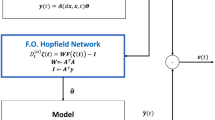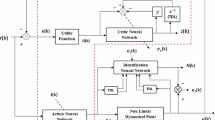Abstract
In this work, a novel method, based upon Hopfield neural networks, is proposed for parameter estimation, in the context of system identification. The equation of the neural estimator stems from the applicability of Hopfield networks to optimization problems, but the weights and the biases of the resulting network are time-varying, since the target function also varies with time. Hence the stability of the method cannot be taken for granted. In order to compare the novel technique and the classical gradient method, simulations have been carried out for a linearly parameterized system, and results show that the Hopfield network is more efficient than the gradient estimator, obtaining lower error and less oscillations. Thus the neural method is validated as an on-line estimator of the time-varying parameters appearing in the model of a nonlinear physical system.
Similar content being viewed by others
References
Abe, S.: Theories on the Hopfield Neural Networks. In: Proceedings IEE International Joint Conference on Neural Networks, Vol. I. (1989) pp. 557–564.
Atencia, M. A., Joya, G. and Sandoval, F.: Modelling the HIV-AIDS Cuban Epidemics with Hopfield Neural Networks. In: J. Mira and J. R. Álvarez (eds.): Artificial Neural Nets. Problem Solving Methods. Lecture Notes on Computer Science (IWANN 2003), Vol. 2687. (2003) pp. 449–456.
Atencia, M. A., Joya, G. and Sandoval, F.: Parametric identification of robotic systems with stable time-varying Hopfield networks, Neural Computing & Applications, 13 (2004), In press.
M. Cohen S. Grossberg (1983) ArticleTitleAbsolute stability of global pattern formation and parallel memory storage by competitive neural networks IEEE Transaction on Systems,Man and Cybernetics 13 IssueID5 815–826
R. M. Golden (1986) ArticleTitleThe brain-state-in-a-box neural model is a gradient descent algorithm Journal of Mathematical Psychology 30 IssueID1 73–80
R. M. Golden (1993) ArticleTitleStability and optimization analyses of the generalized Brain-State-in-a-Box neural network model Journal of Mathematical Psychology 37 IssueID2 282–298
R.M. Golden (1990) Mathematical Methods for Neural Network Analysis and Design. MIT Press Cambridge, MA
J. Hopfield (1982) ArticleTitleNeural Networks and physical systems with emergent collective computational abilities Proceedings of the National Academy of Scinces USA 79 2554–2558
J. Hopfield (1984) ArticleTitleNeurons with graded response have collective computational properties like those of two-state neurons Proceedings of the National Academy of Sciences USA 81 3088–3092
G. Joya M. A. Atencia F. Sandoval (2002) ArticleTitleHopfield neural networks for optimization: study of the different dynamics Neurocomputing 43 IssueID1–4 219–237
H.K. Khalil (2002) Nonlinear Systems Prentice Hall New York
L. Ljung (1999) System Identification Theory for the User. Prentice Hall New York
R. Marino (1997) ArticleTitleAdaptive control of nonlinear systems: basic results and applications Annual Reviews in Control 21 55–66
R. Marino P. Tomei (1993) ArticleTitleGlobal adaptive output-feedback control of nonlinear systems, Part II: nonlinear parameterization IEEE Transaction on Automatic Control 38 IssueID1 33–48
Pedroso-Rodríguez, L. M., Marrero, A. and Arazoza, H.: Nonlinear parametric model identification using genetic algorithms. In: J. Mira and J. R. Álvarez (eds.):Artificial Neural Nets. Problem Solving Methods. Lecture Notes on Computer Science (IWANN 2003), Vol. 2687, (2003), 473--480.
T. Samad P. Harper (1990) ArticleTitleHigh-order Hopfield and Tank optimization networks Parallel Computing 16 287–292
J.-J Slotine W. Li (1991) Applied Nonlinear Control. Prentice Hall New York
M. W. Spong M. Vidyasagar (1989) Robot Dynamics and Control John Wiley & Sons New York
D. Tank J. Hopfield (1985) ArticleTitle‘Neural’ computation of decisions in optimization problems’ Biological Cybernetics 52 141–152
H. Unbehauen (1996) ArticleTitle‘Some new trends in identification and modeling of nonlinear dynamical systems’ Applied Mathematics and Computation 78 IssueID(1985) 279–297
M. Vidyasagar (1993) Nonlinear Systems Analysis Prentice Hall New York
Author information
Authors and Affiliations
Corresponding author
Rights and permissions
About this article
Cite this article
Atencia, M., Joya, G. & Sandoval, F. Hopfield Neural Networks for Parametric Identification of Dynamical Systems. Neural Process Lett 21, 143–152 (2005). https://doi.org/10.1007/s11063-004-3424-3
Issue Date:
DOI: https://doi.org/10.1007/s11063-004-3424-3




